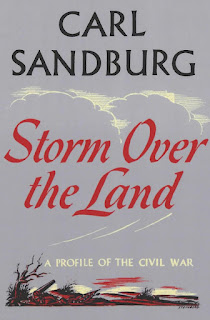STORM OVER the LAND: A PROFILE of the CIVIL WAR by Carl Sandburg

Originally published in 1942 by Harcourt, Brace and Company, Inc. I read a 2009 re-print published by Konecky and Konecky. Carl Sandburg (1878-1967) In 1940, the famed poet, journalist and author Carl Sandburg won a Pulitzer Prize for his four volume biography Abraham Lincoln: The War Years (published in 1939.) In 1942, his publishers came to him and asked him to re-work the biography into a history of the Civil War in response to America's recent entry into World War II. The result is a pretty solid history of the Civil War from basically the Union point of view. Carl Sandburg is best known as a poet and that shines though with some of his prose. From time to time, he comes up with a different and interesting way of telling the story of the war. The most obvious weakness to this history is the story of African-Americans in the war - the free, the enslaved, the recently freed, the soldiers and others. He mentions them, but does not look at them very hard. To be ...





